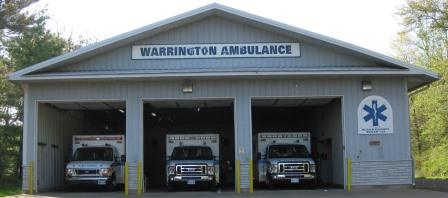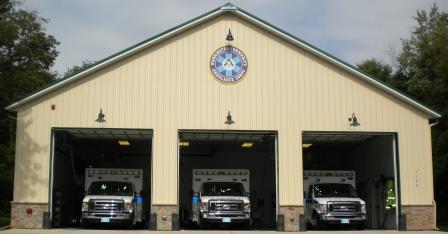Our History


The WCAC traces its history back to the year 1970. In October, a now retired Warrington Township Police Officer and member of the Warrington Jaycees named Dan Gallagher approached the Warrington Jaycees and asked why the township did not have an ambulance service for the community. As a result, the Jaycees formed a Committee that would investigate the need for such a service. They also utilized the services of the Horsham Squad as a consultant.
The Committee’s data supplied by State and Local police reports showed that the community of more than 8,000 people often waited upwards of 30 minutes for an ambulance to arrive. The squads from Horsham, Warminster, Chalfont and O.P. James of Doylestown borough were the responding ambulances.
In the fall of 1971, Articles of Incorporation were filed with the Commonwealth of Pennsylvania creating Warrington Community Ambulance Corps, WCAC. Chartered as an independent, non-profit 501organization, a formal set of by-laws and Board officers were established. It was also established that all Board Officers would be residents of Warrington Township. The Charter Members were Dan Gallagher, Lee Daley, Roy Cain, James Lee, Edward Rahn, Kenneth Daley and Robert Bauman, respectively
In 1971, the very first site was located at 2410 Stagner Avenue. This was courtesy of Mr. Peter Nielson. He was a local businessman, who provided the squad with a garage. This was rent free and included heating and electricity.
As is often the case with growing organizations, the WCAC has had several homes over the intervening years. The first ambulance was housed on the driveway of Dan Gallagher. It was also in November of that year that the first volunteers began their “medical careers” by taking first-aid classes.
The squad’s first ambulance was a 1963 Cadillac and was purchased for $3,600.00. This purchase was subsidized by a generous contribution of $1,500 from the local Lions Club.
On February 1, 1972, those who successfully completed training were referred to by quaint titles of “First Aid Men” or “First Aid Nurses” and began street operations.
The second site for the squad was built in 1973 and located behind the Community Building at 1248 Easton Road. This structure housed the now expanded fleet of two ambulances, which had two bays, an office and a training/ready room. Both the fully equipped ambulances and the building were dedicated on January 26, 1974 in the memory of Joseph Barness, Sr. Mr. Barness, Sr. was an early squad benefactor, who passed away before the building was completed.
In 1978, the WCAC entered the modern age of pre-hospital emergency care when they were able to purchase a mini-mod ambulance that was designed to carry Advanced Life Support equipment. Members received advanced training and certification as Paramedics. It was in 1979 that our first Paramedics were fully qualified and in 1980, our first Mobile Intensive Care Unit was officially operational and provided advanced life support services to Central and Upper Bucks County communities. By May 1989, the squad staffing was composed of three full-time Paramedics, covering day work and 30 volunteer EMTs covering nights and weekends. The squad answered 100 plus calls per month.
In 1991, the squad moved into its third and current home. A newly built building located at 1140 Easton Road. This building has three bay doors, housing three ALS units, a fully equipped bunkroom, providing sleeping accommodations for 10 crewmembers, upstairs shower facilities, a large meeting/training room and a lounge area with efficiency kitchen facilities.
In addition to ALS/911 response, WCAC also ran a medical transport service in the 1990’s when, due to mounting expenses and poor financial return, the service was discontinued in favor of putting all of its resources into providing quality emergency 911-response service exclusively.
In 1998, while serving a growing township population of now 12,169 residents, the squad underwent a major change and reorganized its operations and administration. It was at that time that in addition to its elected volunteer members, the WCAC welcomed onto the Board of Directors, two (2) new positions. The first position would be filled by a member of the community, the other for a representative of the Township’s Board of Supervisors. This Board composition was to remain in place until the next period of major change in the new millennium.
Any healthy, developing organism learns with time to adapt to the demands of the changing environment. So too with organizations where the only constant is change. In this regard, WCAC is no different from any other organization, in adapting to the demands of change.
While WCAC had its origins in the heyday of volunteerism and functioned for many years as primarily a volunteer organization, it had to accept the reality that the volunteer pool has shrunk considerably overtime.
WCAC now depends on a partnership of paid career Paramedics, Medics, PHRN’s, EMT’s and volunteers. The current staffing is made up of five career Paramedics, 1 volunteer Paramedic, 5 career EMTs and volunteer EMT’s. The volunteer staffing represents approximately $100,000.00 in service time. This is based on a minimum requirement of 40 hours active duty every two months. This is approximately 7,000 donated volunteer hours per year.
While the total number of volunteers may look good on paper, what is hard to portray is the fact that many of these individuals quickly move on to paid positions, go back to school or leave the volunteer pool altogether. The volunteer force, with a few exceptions, remains one of the higher turnover positions.
Incentives have been graciously provided by the Township to encourage more members to remain on active status. A Volunteer Incentive Program was created were volunteers are eligible to receive a nominal monetary award for the hours of active service and free access to the community swimming pool during summer months for the volunteer and their immediate family.
With the new reality-driven changes, the squad has seen in staffing, organization and housing, there has also been a major change in the service levels over the years.
In 1971 the squad’s first year in service with a population of approximately 8,000, covering 27 square miles, 500 calls of all types were answered. In Mid-May of 1989, the squad responded to an average of 105 calls per month. In 2004, it increased to 857 calls. In 2006 saw the squad responding to 1,820 calls, for which 538 were basic life support, 959 were advanced life support. In addition, 260 responses were to motor vehicle accidents without extraction and 16 motor vehicle accidents requiring extraction procedures. The squad also assisted that year at 41 structural fires. Squad 129 also received coverage from neighboring squads in 127 instances while in turn we provided 291 assistance calls. While the square mileage of our first due area has remained the same since 1971, the population has increased from 8,000 to approximately 25,000 individuals.
As with every business and household, making ends meet, paying the bills, buying groceries, supplies or refurbishing the furniture or equipment is a never-ending chore. So too with an ambulance squad which operates as a non-profit organization.
To provide a point of reference, in 1978 costs were $1,200 for supplies/equipment, $1,000 for gas/oil, $760 heating/electric, and $960 for telephone. The costs for 2007 have risen to $10,000 for gas/oil, $13,000 medical supplies, $27,000 for medical equipment and administrative costs in the area of $100,000 (legal, training, computer, insurance, accounting fee, etc.). In comparison the actual operating budget costs for 2007, not including salaries for staff was $270,435.
Where does this money come from to operate what is a modest sized non-profit organization? In 2007, the squad received the bulk of its financial support from insurance re-imbursements, annual fund drive, township tax monies for fire department/rescue squad services and whatever grant monies we can successfully apply for and receive.
There is an old saying in the field of organizational development and change that “the only person who likes or appreciates change is a baby with a wet diaper.” The fact is, any organization that is not ready to make appropriate change will likely go extinct.
In 2005, the WCAC Board of Directors concluded that, while we were not anywhere near extinction it was still the right time to begin planning for the future of the squad, materially and financially. In essence, we needed to put into place a Five Year Plan.
One of the first objectives was finances. There was a need to invest and plan for the future. These investments will include major expenditures such as new ambulances and equipment and a building fund.
From an operations standpoint, the squad has gone with a paid Chief’s position and has added several line officers to ensure that there will be a pool of trained personnel to move up in the ranks and increase the incentive for career staff to remain with this organization.
To ensure a continued high level of service delivery, the career employee’s job performance process has been enhanced. There is in place a formal Mentoring Program for both new career employees and volunteers. Annual job performance appraisals are preformed for both career and volunteer staffing.
WCAC has been replacing ambulances on a regular schedule and will need to continue to do so. An engineering assessment was completed on our building and we began an intensive plan for a replacement.
Organizationally, the squad, with the assistance of LaSalle University’s Non Profit Center as consultants, has begun a multi-phased process of major organizational change. The most recent addition has been adopted August 26, 2007.
As part of the By-Law revision, there has been a major change in the make-up of the Board of Directors. Under the previous By-Laws, the Board of Directors consisted of a maximum of seven members, Township Coordinator and one member of the Township Board of Supervisors, two members of the public and three active members of the Corps. The new Board of Directors will be comprised of not less than 7 and no more than 13 voting members. Only two members of the Board of Directors will be volunteer members and one seat must be filled by a representative of the Township. The balance of participants will consists of community volunteers from various walks of life. The intent here is to establish a Board membership that brings to the table a wide range of expertise to enable the squad to continue to grow and develop to a successful non-profit business.
At the beginning of this brief history, we spelled out what we as an organization saw as its primary Mission and area of expertise. To provide quality pre-hospital emergency services to the surrounding community. In reality, this has always been the mission of Medic 129 from its founding in the early seventies by Dan Gallagher and his contemporaries through the ensuing decades to the present day from each employee, volunteer and Board of Director